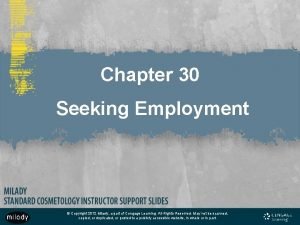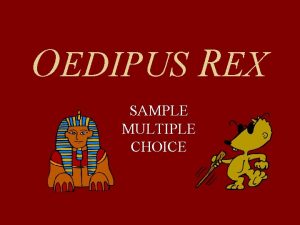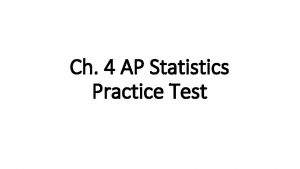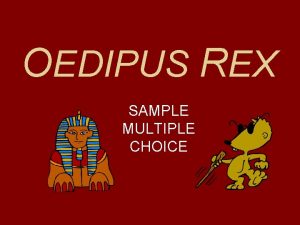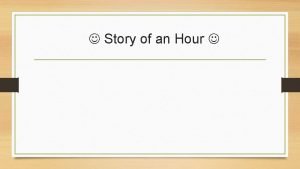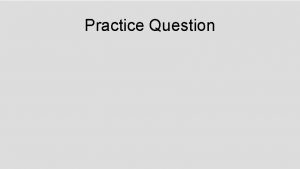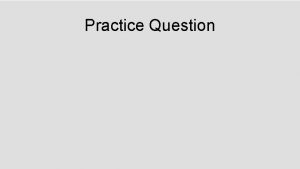HSC Practice Multiple Choice QUESTION 1 What was

















- Slides: 17

HSC Practice Multiple Choice

QUESTION 1 What was the name of the archaeologist who developed the technique of plaster casts a) b) c) d) Karl Weber Amedeo Maiuri Giuseppe Fiorelli Vittorio Spinazzola

QUESTION 2 In which century did the above archaeologist employ this technique? a) b) c) d) 20 th century 19 th century 18 th century 17 th century

QUESTION 3 What are the structures in the Source? a) b) c) d) Mills for making flour The remains of a temple Pots used for storing olive oil Stone ovens used for baking bread

QUESTION 4 Wall Inscription On the 18 th of June in the duumvirate of Lucius Veranius Hypsaeus and Lucius Albucius Justus, I, Privatus, slave of the colony of Pompeii, declared in writing that I had received from Lucius Caecilius Jucundus 1, 675 sesterces, and previous to this day, on June 6, I received 1000 sesterces as rent for the public pasture. What does Source C reveal about the duties of slaves? a) b) c) d) Slaves had to keep dates of all transactions Slaves were required to report to the duumvirate Slaves were permitted to receive payments on behalf of their masters Slaves were responsible for recording all financial transactions in the colony

QUESTION 5 Inscription from Wax Tablet “Umbricia Ianuaria declared that she had received from L. Caecilius Iucundus 11, 039 sesterces, which sum came into the hands of L. Caecilius Iucundus by agreement as the proceeds of an auction sale for Umbricia Ianuaria, the commission due him having been deducted. Who is the intended recipient of the money paid in Source C? a) b) c) d) Privatus Lucius Caecilius Iucundus A. Paconius Sabinus and A. Petronius Cannot be determined from the evidence

QUESTION 6 Is the recreation in Source D most likely to be in Pompeii or Herculaneum? a) b) c) d) Pompeii, because of the street design Herculaneum, because of the street design Pompeii, because of the structure of the houses Herculaneum, because of the structure of the houses

QUESTION 7 What is Source E a plan of? a) b) c) d) Stabian Baths Roman Forum of Pompeii Villa of the Papyri

QUESTION 8 What is the feature shown in Source F? a) b) c) d) A lararium A peristyle An impluvium A compluvium

QUESTION 9 What activity commonly took place in the Palaestra in the Source? a) b) c) d) Voting Markets Exercising Worshipping

QUESTION 10 Extract of Graffito “Marcus Cerrinius for aedile. Some people love him, some are loved by him, I can’t stand him. - Who loathes, loves. ” - Eumachia The graffito in the Source provides evidence that women took part in which activity? a) b) c) d) Voting in elections Funding election campaigns Trying to influence election results Standing for election to public office

QUESTION 11 An inner courtyard found in a typical house in Pompeii, featuring trees, shrubs, statues and often a fountain, was known as what? a) b) c) d) A fresco A cubicula A peristyle A gardenia

QUESTION 12 Who is / what are sesterces? a) b) c) d) Roman currency? A Roman god of wealth and extravagance Public fountains placed at main intersections throughout town Stones placed in the middle of roads so people could cross without getting their feet wet

QUESTION 13 If I were standing in the middle of the atrium in a Pompeian house looking directly up, what would I be looking at? a) b) c) d) The sky A painting The impluvium A vaulted ceiling

QUESTION 14 Houses in Pompeii and Herculaneum were built in sections known as what? a) b) c) d) Insula Culina Rostra Basilica

QUESTION 15 Romans in this time worshipped household gods who protected the home and the family. What were these known as? a) b) c) d) Alae Lares Culina Fauces

QUESTION 16 With Reference to the Sources Explain the significance of the “warrior pharaoh” iconography to a Pharaoh’s reign? 5 marks
 Hsc multiple choice practice
Hsc multiple choice practice Information processes and technology past papers
Information processes and technology past papers Chapter 30 milady review questions
Chapter 30 milady review questions Osslt grammar practice
Osslt grammar practice Oedipus multiple choice questions
Oedipus multiple choice questions Ap stats practice test multiple choice
Ap stats practice test multiple choice Ap lang multiple choice tips
Ap lang multiple choice tips Ap lit multiple choice tips
Ap lit multiple choice tips Creon expresses all of the following except?
Creon expresses all of the following except? What is a costa level 3 question
What is a costa level 3 question Hsc minimum standard
Hsc minimum standard Good choice or bad choice
Good choice or bad choice How to write multiple choice questions
How to write multiple choice questions Multiple binary choice items
Multiple binary choice items Tarry a little there is something else
Tarry a little there is something else The story of an hour multiple choice test
The story of an hour multiple choice test What is stimulus in mcq
What is stimulus in mcq Conjunctive adverbs quiz
Conjunctive adverbs quiz


